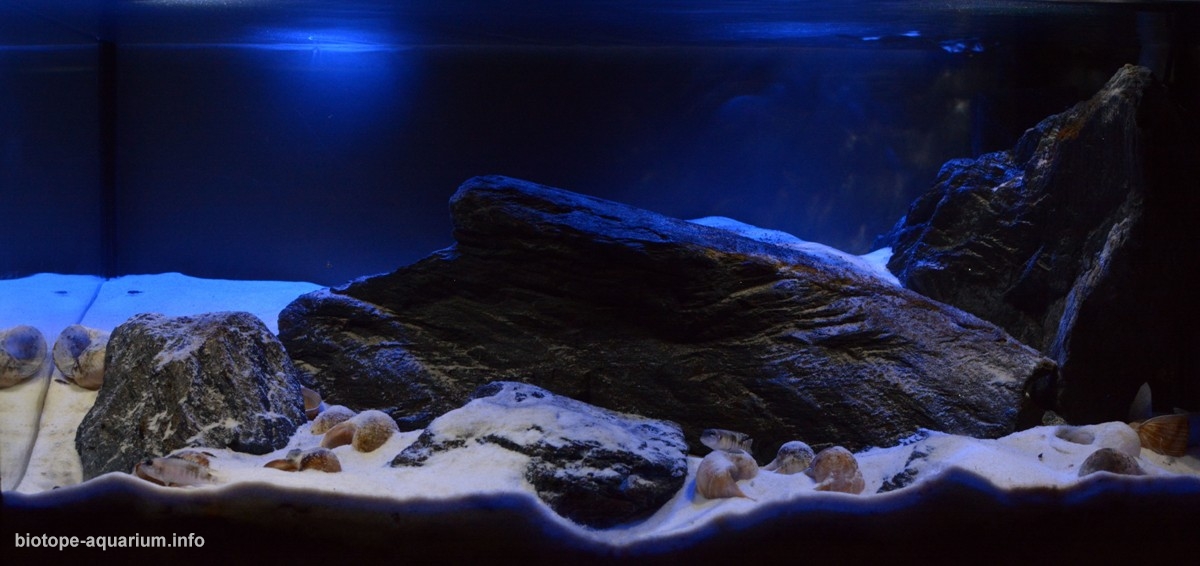Lamprologus speciosus, south of Kalemie, Tanganyika, Zair
88th place in Biotope Aquarium Design Contest 2019
Poland. Arkadiusz Skrzycki

Volume: 54 L
Dimensions: 60x30x30 cm
List of fishes: The stock is composed with a pair of Lamprologus speciosus, which regularly approaches spawning
List of plants: N/A
Description of decorations: The substrate is sand JBL Sualesi, Black stone, and shells vineyard.
Description of equipment: The filtration is divided into mechanical filtration for which the aquana FZN1 cascade corresponds, and biological filtration aquael mini kani 120 filled to the brim with expanded clay. Heater 75 W, Lighting is a DIY led lamp, which I made using LED modules with power 0.36W 2x7500K, and 2x blue
Water parameters: water temperature is 26°C, pH 8.5, gh 6, kh 13, TDS 354.
Additional info: This aquarium is a continuation of Tanganyika, Zair, south of Kalemie, Lamprologus speciosus from last year’s edition of this competition. The changes that followed resulted in slightly improved lighting and made lighting from led modules.
INFORMATION ABOUT BIOTOPE
Description of the area surrounding the biotope: Tanganyika – a lake in East Africa, one of the Great African Lakes, located in the East African rift zone, in the Great Western Rope, in the territory of Zambia, Democratic Republic of the Congo, Burundi and Tanzania. It covers an area of 34.4 thousand. km². This region is located in the so-called The Great Western Rope, one of the Great African Ruts. Lake Tanganyika was created like other large lakes from this area due to tectonic movements of the Tertiary period.
Description of the underwater landscape of the biotope: Coast of the Democratic Republic of the Congo (Zaire), south of Kalemie. The landscape of this underwater world can be compared to the landscape of the moon, the sandy zone with rocks and groups of shells, which inhabit cichlid species called seashells. Their characteristic feature is that they use empty shells as shelters and places for reproduction.
Description of the parameters of the habitat: Lake Tanganyika is located in the middle humid tropical climate zone. The average annual rainfall is about 200 mm, and the average annual temperature is around 20 ° C. The waters of Tanganyika Lake are chemically described as sodium – potassium – bicarbonate waters and their composition is described as permanent. The electrolytic conductivity is between 600 – 620 μS. the pH of the water is determined by the bottom made of alkaline lava, which causes an increase in the pH of water in the lake is in the range of 7.5 – 9.2. In the coastal zone the pH is higher than in other zones, because the wave is stronger at the edge, which results in good oxygenation of the water and a reduction in the amount of carbon dioxide. The water in Lake Tanganyika is very clean, its clarity is around 20 meters. General hardness GH 7-11 ° n, carbonate hardness KH 16 – 18 ° n.
List of fishes and invertebrates occurring in the nature biotope: Lake Tanganyika offers over 350 species of fish, most of which are endemic species. Like Lake Malawi, Lake Tanganyika is extremely old, and the combination of its age and ecological isolation has led to the evolution of exceptional fish populations. As new species are constantly discovered in these unusual lakes, it is difficult to determine which one has the greatest diversity, but at least they share this distinction as the two largest lakes in the world in terms of biodiversity, while Lake Tanganyika has the highest level of endemicity, mainly concentrated in Zambian waters of the lake. The lake is inhabited by fish of the genus: Tropheus, Lamprologus, Julidochromis, Petrochromis, Xenotilapia, Callochromi, Cyathopharynx. Tilapia, Simochromis, Ctenochromis.
List of plants found in the nature biotope: Plants in Lake Tanganyika occur up to a depth of 10 meters, then we only deal with the beautiful and unique lunar landscape. Najas marina, Vallisneria spirali, Ceratophyllum demersum, Chara sp., Hydrilla verticillata, Potamogeton schweinfurthii, Potamogeton pectinatus, Pistia stratiotes, Myriophyllum spicatum.
List of plants found in the nature biotope: Plants in Lake Tanganyika occur up to a depth of 10 meters, then we only deal with the beautiful and unique lunar landscape. Najas marina, Vallisneria spirali, Ceratophyllum demersum, Chara sp., Hydrilla verticillata, Potamogeton schweinfurthii, Potamogeton pectinatus, Pistia stratiotes, Myriophyllum spicatum.
Threats to the ecology: –
Sources of information:
http://klub-tanganika.pl/
https://pl.wikipedia.org/wiki/
http://muszlowce.pl/speciosus/
https://www.zambiatourism.com/
http://www.tanganika-twm.pl/
http://4szyby.blogspot.com/
Everta van Ammelrooy – Tanganika Magazyn nr. 6
